| Botanical Name |
|
| Family |
Iridaceae - The iris family. |
| Pronunciation |
|
| Common Name(s) |
English: Falling stars; Montbretia
IsiZulu: Umlunge; Udwendweni
|
| Plant Group |
- Bulb / Corm / Rhizome / Tuber / Epigeal bulb Bulbs: are made up of fleshy scales as in an onion
Corm: a short, swollen, underground stem that is hard and not fleshy as in a gladiolus
Tuber: a solid, fleshy, underground, storage organ as in a potato
Rhizome: an underground, horizontal, swollen stem at the base of the plant as in an iris
Epigeal bulb: bulbs that rest above the ground with only the roots anchoring the plant to the earth as in albuca
|
| Plant Size |
- Medium to Large
| Tree | 15m to 20m |
| Shrub | 2m to 3m |
| Perennial/ground cover | 60cm to 75cm |
| Bulb | 60cm to 1m |
| Succulent | 60cm to 1m |
|
| Position |
- Canopy Shade Canopy shade is found below closely grown trees where some light filters through. Ideal for the protection of herbaceous plants.
- Dry Shade Shady areas where soil has poor water retention or are dependent on rain for their moisture needs.
- Light or Dappled Shade Found below trees with sparse, open foliage. Ideal for the protection of herbaceous plants.
- Partial Shade The area is in shade for part of the day and in full sun for part of the day.
|
| General Information |
- Deciduous Plants which completely lose their foliage for part of the year.
- Drought Tolerance: Moderate The plant is moderately adapted to arid conditions and can survive short periods of drought and high temperatures without extra water.
- Frost: Tender A plant that will not survive any frost or low winter temperatures.
- Water Moderate These plants will need some extra watering compared to water-wise plants. Plant them together, in at least some shade and in a convenient proximity to the house so that grey water can be utilised during times of drought.
|
| Specific Information |
Crocosmia aurea loves moist habitats and forms large communities in the wild. The attractive foliage is 2-3 cm wide, sword shaped and can grow up to 1.2 m tall. The fruits are orange red with shiny black seeds and may be useful in dry arrangements as they keep their colour for a long time.
|
| Ad Break |
|
| Flowers |
| Description |
tall branched stems with spikes of star-shaped flowers up to 40 mm across
|
| Season |
- Summer to Autumn Plants will seldom bloom for the entire season as given in the list, but should flower during a period within these parameters.
|
| Colour |
|
| Growth Rate |
- Moderate to Fast Specifying growth rate can be very misleading as there is considerable variation of growth rate depending on type and species of plant, available water, supplementary feeding, mulching and general care, as well as the plants suitability and adaptability to the garden environment.
|
| Plant Uses |
- Attracts bees, butterflies or other insects This plant attracts insects which can be food for birds or other creatures in your garden.
- Attracts Birds This plant will attract birds.
- Border A strip of ground, at the edge of a driveway or path in which ornamental plants or shrubs are planted.
- Container Trees, shrubs and ornamental species that can adapt to growing in a restricted environment.
- Cut Flowers Plants that provide flowers suitable for ornamental uses.
- Filler Either a fast growing tree or shrub used temporarily to fill in an area while the permanent plants grow to a desired size, or a plant used to fill gaps in borders or beds.
- Interplanting Arranging and planting plants in the garden that have different blooming times and habits of growth, extending the amount of time in which the area is in flower.
- Mass Planting Plants useful for filling a large area with just one or a few kinds of plants spaced close together. Creates a bold, dramatic effect and to reduces maintenance.
- Wild Garden An indigenous garden planted for the benefit of wildlife and birds. Provides food, water, a variety of mini-biomes and no poisonous chemicals are used.
|
| Distribution and Habitat |
in the Eastern Cape, KwaZulu-Natal, Mpumalanga, Limpopo and Swaziland, in moist habitats along stream banks, in wooded kloofs (ravines) and along forest margins
|
| Planting Suggestions |
Plant corms of Crocosmia aurea in late winter or early spring, about 4 cm deep, in soil to which compost has been added and mulch well. Flowering during the first season after planting may be limited. Leave undisturbed for a few years if possible to allow the corms to multiply. Fertilize occasionally if the soil is poor. Water well in summer.
|
| Medicinal Uses |
Used in traditional medicine to treat dysentery.
|
| Ad Break |
|


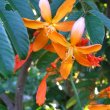
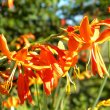
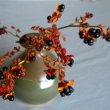
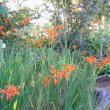
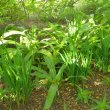
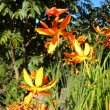


Comments
crocosmia in traditional medicine
Hi Lorraine,
With respect to crocosmia use in traditional medicine, are you aware of any articles or books which specifically discuss and document the use and preparation?
many thanks,
J.P.
Medicinal use of Crocosmia
Hi J.P.
I checked all my medicinal plant books and did a search on the internet but found little information about how the plant might be prepared. The following sites give a little information:
http://ip.com/patfam/en/13737260
http://www.gardenguides.com/125430-crocosmia-edible.html
http://plants.jstor.org/upwta/2_886
One also has to bear in mind that the plants are used in different ways by the various population groups within their distribution range, while some groups may not use it at all.
Sorry I can't be more specific.
Kind regards
Lorraine
Discuss this plant
Share knowledge, ask a question or give an experience.